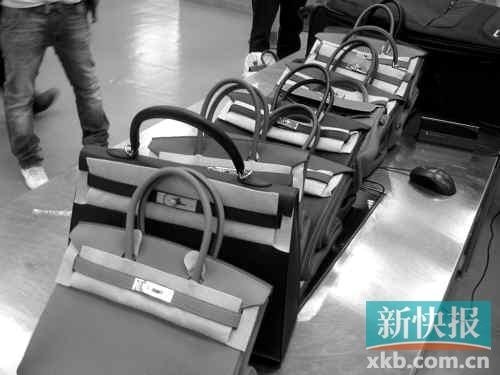
Guangzhou customs officials inspect wine bottles. Smuggling wine from Hong Kong to the mainland is a lucrative operation for those who don't get caught.
China’s anti-corruption campaign may have slowed luxury sales, but the persistent activity of the Chinese “gray market” made possible by “overseas shippers” (Chinese: shuike, 水客)—a modern-day expression for luxury-goods smugglers—has proven that the domestic luxury appetite remains insatiable.
On March 26, the China News reported that Huangpu customs in Guangzhou busted a mainland couple arriving via the Guangzhou-Kowloon Through Train smuggling goods worth 150,000 yuan (about US$24,000), including Lafite wines and Italian-branded shoes. According to the story, the couple's attempt marked a classic example of experienced smugglers who often take advantage of a multi-entry permit for Hong Kong to bring luxury goods to the mainland and sell them for a cheaper price than regularly taxed items. Huangpu customs has also observed many have now chosen to take alternative routes and enter at the Dongguan port. One day earlier, the Guangzhou Daily reported a Hong Kong man was found sporting 7,000 diamonds and 10 pieces of gold jewelry in his underwear at a checkpoint in Shenzhen.
Similar smuggling cases can be seen almost every month on Chinese media. Smugglers most commonly try to sneak into the mainland with goods from Hong Kong, where imported luxury items are much cheaper than on the mainland China thanks to lower taxes.

Bags seized in a luxury smuggling bust.
In late November last year, the China News revealed a story on a Hong Kong citizen who was caught with 15 luxury watches tied to his ankles while entering the Futian port in Shenzhen. The watches were from high-end Swiss brands such as Vacheron Constantin, Patek Philippe, Jaeger-LeCoultre, and Girard-Perregauz and worth 2,370,000 yuan (about US$381,000) collectively, which amounted to a tax evasion of 710,000 yuan. He was offered a 1,000-yuan reward by his employer for the risk.
Electronics are another popular category for smugglers. In a Nandu News story published in October last year, a Shunde, Guangdong citizen was discovered carrying Apple products worth 160,000 yuan while crossing the checkpoint.
In 2013, Huanggang and Futian customs caught 70 smuggling instances, amounting to a total of 400 watches. Meanwhile, Shunde customs busted 31 instances of electronics, cash, and jewelry smuggling worth 4,000,000 yuan in total during the first nine months of 2013.
Some smugglers venture far beyond Hong Kong to pick up cheaper luxury goods. XinKuaiBao published a story in early December last year that three Hong Kong and mainland passengers crossing the border at the Huanggang port in Shenzhen were caught smuggling 26 Hermès bags from Argentina worth approximately 1,700,000 yuan collectively.
From the looks of these frequent reports, the Chinese government is working to convey an image that it has been trying to crack down on smuggling. Two of the most-reported cases were those of two Taobao sellers and a former stewardess smuggling large quantities of goods from Korea; the former were sentenced to imprisonment of more than one year and a fine, and the latter three years and a fine. In order to cut down on this massive black market, customs officials in the areas mentioned above have now been strengthening measures to screen suspected “overseas shippers”with the use of X-ray images.